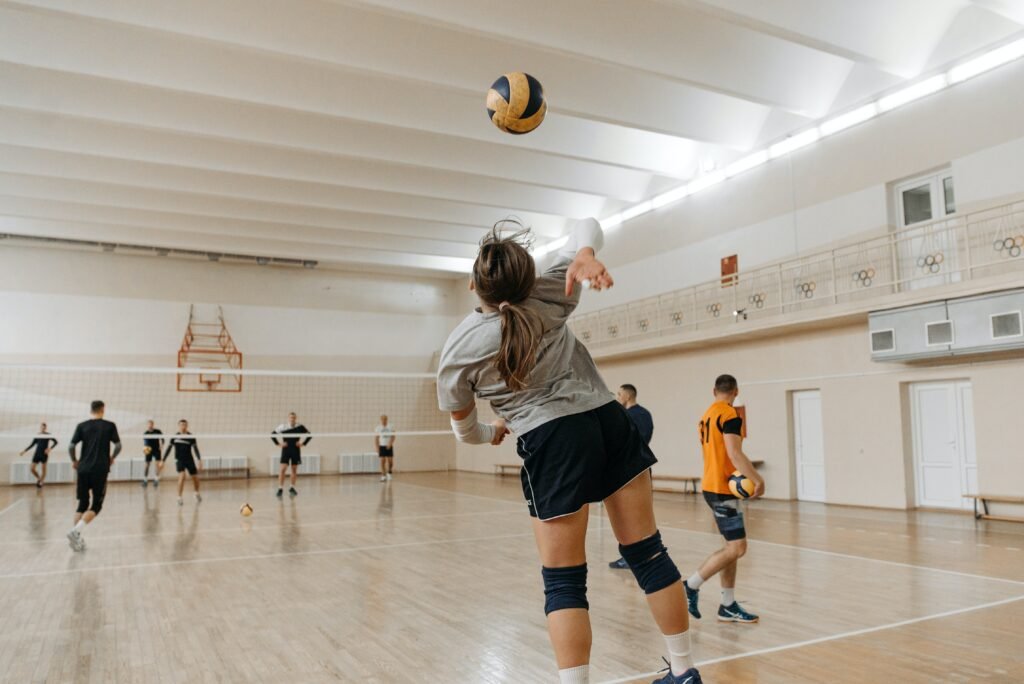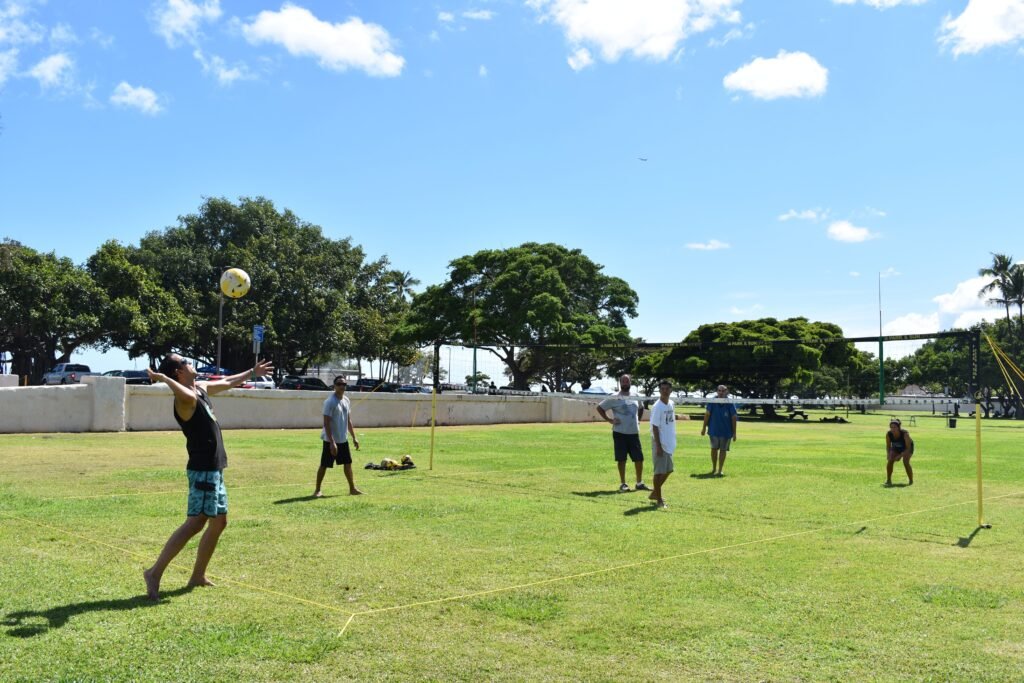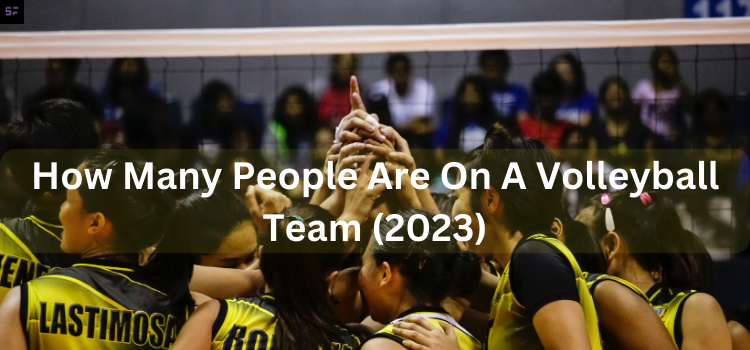Key Takeaways:
- Basics: Volleyball has teams of six aiming to ground the ball on the opponent’s side.
- Roles:
- Attackers: Spike the ball over the net.
- Defenders: Block opponent’s attacks.
- Libero: Main receiver; wears a distinctive shirt.
- Setter: Sets to hitters and leads team communication.
- Defensive Specialist: Versatile role for ball control.
- Variants:
- Beach Volleyball: 2-player game on sand.
- Indoor Volleyball: 6-player game on hard courts.
- Grass Volleyball: 3-4 players on grass courts.
- Substitution Rules:
- Generally unlimited, with specific conditions.
- Libero substitutions are distinct and frequent.
Volleyball is a sport played by two teams of six players on a rectangular court divided by a net. The objective of the game is to send the ball over the net and ground it on the other team’s court, and prevent the same effort by the opponent.
Knowing the number of players on a volleyball team is important for various reasons. It helps players understand their roles and responsibilities, helps organizers plan and allocate resources effectively, and helps fans understand and appreciate the game better.
In this article on how many people are on a volleyball team, we will explore this in depth.
Table of Contents
How Many Players Are On A Volleyball Team: Team Basic Structure
Number of players on a Volleyball team
- A standard volleyball team consists of six players.
- The six players are divided into two rows of three players each.
- The front row is comprised of three attackers and the back row is comprised of three defenders.
- The players switch positions after every rally or point.
Read this article on essential knowledge needed to play volleyball.
Roles and Responsibilities of each player
Attackers (also known as hitters):
- Responsible for spiking or hitting the ball over the net into the opponent’s court.
There are two types of hitters:
Outside Hitter
- also known as the left-side hitter
- lead attacker in an offensive strategy
Opposite Hitter
- also known as the right-side hitter
- needs to be a perfect balance of both offense and defense.
Defenders (also known as blockers):
- Responsible for blocking the opposing team’s attacks and attempting to prevent the ball from hitting the ground on their side of the court.
- Middle Blocker is the tallest member of the team and the first line of defense.
Libero:
- The main receiver of the opponent’s attack.
- Responsible for passing the ball to the setter and playing defense.
- Always stays in the back row
- Wears a different color shirt than the rest of the teammates
Setter:
- Responsible for setting the ball to the hitters and running the offensive plays.
- Must have a delicate touch when setting to one of the hitters.
- The main contributor to the attack hence needs to be the main communication source in the team.
Defensive Specialist
- stands out from other positions due to their ability to replace any other player on the court.
- focuses on passing, ball control, and working together with the libero
Note: The role of each player is crucial in a volleyball game and their responsibilities overlap and intertwine to create a successful play.

Check out volleyballVault.com for Amazing content Related to Volleyball.
Different Forms of Volleyball and their Player Requirements
1. Beach Volleyball
– Beach volleyball is played on sand courts.
– It is a two-player version of the sport, with each player covering half the court.
– Players need to have strong athleticism and endurance, as well as quick reflexes and agility to move on the sand.

2. Indoor Volleyball
– Indoor volleyball is played on a hard court.
– Teams consist of six players, with the same roles and responsibilities as described in Point II.
– Players need to have a combination of strength, power, and speed to play effectively indoors.

3. Grass Volleyball
– Grass volleyball is played on a grass court.
– Teams can range from three to 4 players, but no more than 4 with different rules and regulations based on the number of players.
– Players need to be able to adapt to the softer surface and may need to adjust their footwork and jumping techniques to play effectively on grass.
-Finally, teams must start and end the game with at least 3 players present on the court

How Many People Are On A Volleyball Team: Substitution rules
The substitution rules in Volleyball vary slightly between different organizations and levels of play, but some general guidelines are as follows:
Unlimited substitutions:
Most organizations allow unlimited substitutions during the game, as long as they follow the specific substitution rules.
Dead ball or between sets:
Substitutions can only be made during a dead ball or between sets. A dead ball is when the ball is out of play and no action is taking place on the court.
Substitutions made by coach or designated player:
Substitutions can only be made by the coach or a designated player. The coach or designated player must inform the referees of the substitution and the player being replaced.
A player listed in the score sheet:
The player entering the game must be listed in the score sheet and must be checked in at the scorer’s table.
Replacing specific player:
The player entering the game must replace the player who is going out, and the replaced player must leave the playing area before the new player enters.
Libero substitution:
In indoor volleyball, the libero is a defensive specialist who can only enter the game to replace the back-row player. Libero substitutions do not count as regular substitutions and can be made unlimited times.
It’s important to note that the substitution rules may vary slightly between different levels of play and organizations, so teams should always check with the specific rules of their league or competition.
Adhering to the substitution rules is crucial to maintaining the integrity of the game and ensuring fair competition.
Check out this related post on how to practice volleyball at home.
Conclusion
I hope you liked the above short article on how many people are on a volleyball team. In conclusion, Understanding the number of players in Volleyball is important for players, coaches, and fans alike.
It affects the strategy of the game, the formation, and movements of the players on the court, as well as the number of substitutions that can be made.
FAQs
How many Players are needed to Play Snow Volleyball?
Snow volleyball can be played in different formats, but typically, two teams of three players each compete against each other. This means that a total of six players are needed to play snow volleyball. One player in reserve and 2 substitutions per set
How many players are needed in the sitting volleyball team?
Sitting volleyball is a variation of volleyball designed for players who have a permanent physical disability that prevents them from playing standing volleyball.
In sitting volleyball, each team is allowed to have a maximum of six players on the court at a time, with three players positioned in the front row and three players positioned in the back row.
What are the 5 rules of volleyball?
1. Serving: The game starts with a serve, which is used to put the ball in play. The server must stand behind the end line and hit the ball over the net into the opposing team’s court. The server must also serve within a specific time limit and can’t cross the end line until after the ball is hit.
2. Three touches: Each team is allowed to touch the ball three times before it must be sent over the net. A player can’t touch the ball twice in a row, and blocking the ball does not count as a touch.
3. Netplay: Players are not allowed to touch the net during play, and the ball can’t touch the net during a serve. If the ball hits the net during play, it is still in play as long as it goes over the net and into the opposing team’s court.
4. Boundaries: The ball must stay within the court boundaries during play. If the ball lands on the boundary line, it is considered in play.
5. Scoring: Points are awarded when the opposing team fails to return the ball over the net, or if they commit a fault, such as touching the net. A team must win a set by two points, with each set typically played to 25 points.
